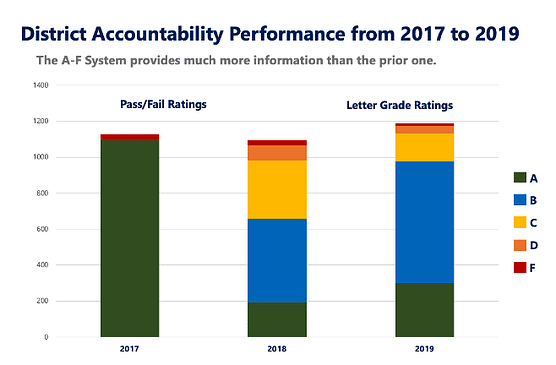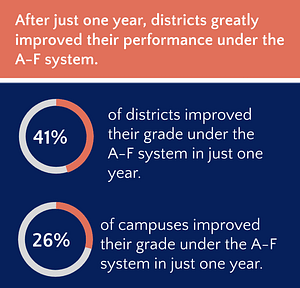The state must continue to care about how every student in Texas is performing academically
The following testimony was submitted by Texas 2036 Senior Policy Advisor Mary Lynn Pruneda to the House Public Education Committee on May 24, 2022.
At Texas 2036, we believe strongly in a valid, reliable, and transparent assessment and accountability system. The students in our system are our state’s future. We owe a special duty to them to provide the best, highest-quality public education that we can. This need is particularly urgent given the Covid-19 pandemic. At this point, it is undisputed that students have experienced profound learning loss due to the pandemic’s disruption of our education system. However, what is in dispute is how we measure this learning loss in our standardized assessment system and how we hold districts accountable for their student’s academic achievement in a post-Covid world.
As the Legislature monitors the impact of Senate Bill 1365, we recommend the consideration of two things:
- The A-F system is complicated, but the data indicates:
○ The system is more transparent than the prior system.
○ High-performing districts (including those with higher levels of poverty) are receiving A grades.
○ The system is driving performance improvements at the district level. - The state’s needs to care enough to find out how every student is doing academically, and it needs to be prepared to act when intervention is necessary to ensure all students have access to a quality education.

1. The data suggests the state’s accountability system is accurately measuring school district performance. When the A-F system is discussed, it is helpful to remember the system that Texas had in place before House Bill 22 (85R) was passed. Under that old system, districts were given one of two ratings, Improvement Required or Met Standard. There was very little information available for parents or policymakers on how schools districts were doing (see chart to the right). By providing more information on district performance, the system is more transparent for parents and other stakeholders.
The data from the A-F system shows that the accountability system is aligning “A” grades with high performance. Data indicates that high-poverty “A” campuses have higher percentages of students ready for college than the state average. In addition, students attending “A” campuses demonstrate 2.5x greater STAAR proficiency than students at “F” campuses.
Another important consideration in the accountability system is whether or not it is driving performance improvements. Data shows that since the A-F system has been in place, the state has seen an increase in the number of “A” campuses and a decrease in the number of failing campuses. From 2018 to 2019 (the only two years where A-F has effectively been in place) the state saw an increase in “A” and “B” campuses and a decrease in “D” and “F” campuses. In 2019, we saw the following performance improvements at districts and campuses:
 For districts:
For districts:
○ 41% of districts improved their grade under the A-F system.
○ 20 districts rated “C” or “D” were “A” rated one year later.
○ 131 districts went from a “B,” “C,” or “D” in 2018 to an “A” in 2019.
For campuses:
○ 26% of campuses improved their letter grade from the prior year.
○ 88 campuses went from a “C,” “D,” or “F” in 2018 to an “A” in 2019.
○ 552 campuses went from a “B,” “C,” or “D” in 2018 to an “A” in 2019.
2. The state needs to care enough to find out how every student is doing academically. The academic life of every child matters, but in order to understand how that student is doing relative to their peers and relative to other students across the state, the state needs to measure their performance. This necessitates that the system include annualized assessment of all students using a valid and reliable measure that tests student learning in core subjects. Without a valid and reliable measure for academic progress on an annualized basis, the state has no comprehensive insight into how students perform at a systems level. Valid and reliable annualized assessment should be an important part of this system because they are comparable. This means that the state can look at data from different districts and campuses and know that they are comparing apples to apples.
As part of this system, data must be disaggregated to highlight the performance of all children in all learning environments. While overall performance certainly matters, disaggregation is necessary to ensure that all student populations have the opportunity to share in our state’s future economic growth. The system should not allow for any gamesmanship or hiding of student groups. A top-level summary of overall campus or district academic performance is not sufficient under this principle. Every subgroup’s information needs to be part of the system’s calculation in an appropriately weighted manner.
Once we know how every student is performing, the state accountability system can be a useful management tool to guide parents, decision-makers, taxpayers, and employers. Parents should be able to use the data from the A-F system to make informed decisions for their children. Decision-makers, like the Legislature, should be able to use the information to highlight best practices and find out which districts are chronically underperforming. The Executive Branch should be able to use the data from a legislatively-devised system to intervene in districts that have underperformed for too long. Taxpayers should be able to use the information to determine if they receive an appropriate value for the property taxes that they are paying. Employers should be able to access data and engage to improve performance at local schools to ensure access to a capable future workforce.
If the state wants to continue to see score improvements for every child in Texas, a strong accountability system is needed. The accountability system, taken in conjunction with the funding elements in House Bill 3, offers the state powerful tools to improve student outcomes. In order to provide the best for our students, we must continue to emphasize disaggregation, comparability, and transparency.
